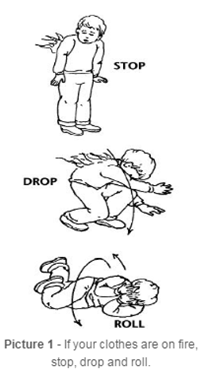Burn Prevention: Activities
Burn Program
Looking for services or physicians who can help treat this condition?

Burns are a common injury to children. Most burns in children are caused by scalding or touching a hot liquid. Other types can be from touching chemicals, something electric or getting burned by fire. Most burns can be prevented by removing the hazards from your home and by learning what to do if there is a fire.
How to Prevent Scalding and Burns Not Caused by Fire
- When cooking, turn pot handles on the stove away so they do not stick out.
- Place appliances like a toaster or coffee maker against the back wall of the counter.
- Put hot drinks or soup in a place where they cannot be reached or tipped over.
- Test hot water temperature before bathing. Put your elbow in the water for 5 to 10 seconds. Water should feel warm and not hot. Set water heater’s temperature to 120 F (Fahrenheit) or 49 C (Celsius).
- If using a space heater, do not leave child alone in the room. Unplug the heater when it is not in use.
How to Escape a Fire in Your Home

If a fire starts in your home, get out fast and call 911 from a neighbor's house. Tell 911 your address so they know where to send the fire trucks.
If Clothing Catches Fire
- STOP, DROP AND ROLL (Picture 1). Do not run!
- Wrap a rug, blanket or coat around you if one is easy to reach. Cover your face with your hands.
- Roll slowly on the floor or ground until the fire is out.
How to Escape a Smoky Place
- Cover your face with a cloth and breathe through your nose.
- Crawl, do not walk. Keep low to the floor to escape heat and smoke.
If Smoke is Coming Under the Door
If you think there is a fire on the other side of the door, do not open it. Test doors before opening them.
- Feel the door with the back of your hand. If it is hot, look for another way to escape.
- Keep your head turned away from the door opening.
- Slowly open the door a crack. After pressure is released, if you only see smoke, get down on your hands and knees and crawl cautiously to safety.
If there is no way out from the fire and only if you are on the first or second floor, escape from the window.
- Go feet first to drop onto a safe area such as grass or bushes
- Avoid landing on walls, fences and hard surfaces
Important Pointers
- Smoke detectors (alarms) save lives!
- Use them on each floor of your home. Test them every month so that you know they work. Change the batteries twice a year (when you change your clocks for daylight savings time).
- You can request a free smoke alarm from the Columbus Fire Smoke Alarm Hotline at (614) 724-0935. Outside the City of Columbus, call (844) 207-4509.
- Make an escape plan. Discuss and practice it so you can be sure everyone gets out.
- Plan 2 ways out of each room.
- Make sure that nothing blocks windows and doors.
- Decide on a meeting place outside your house, like a nearby tree, mailbox, fence or at a neighbor’s house. Make sure each family members knows where the safe meeting place is.
- Choose who will help the youngest child (or any others who might need help) to get out safely. Young children can be hard to wake when sleeping, may get scared or may try to hide.
- Have a way to call 911. Make sure your child knows how to use a phone to call for help. Even cell phones that are not activated can be used to call 911 in an emergency.
HH-IV-60 © 1982, Revised 2020, Nationwide Children ’s Hospital
